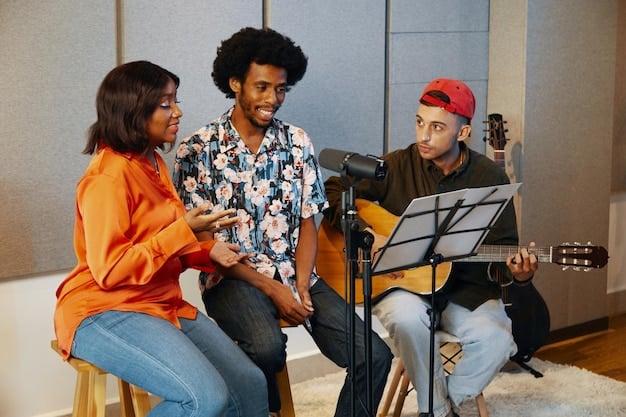Music Streaming Royalties: Are Artists Finally Getting a Fair Share?

The question of whether artists are finally receiving a fair share from music streaming royalties remains complex, with significant disparities persisting between top-tier and emerging musicians despite industry efforts to adjust payment structures, highlighting an ongoing debate over equitable compensation in the digital music economy.
The dawn of the digital age promised a revolution in music distribution, making vast libraries accessible at our fingertips. Yet, beneath the seamless experience of instant access and personalized playlists lies a contentious debate: are artists finally getting a fair share from music streaming royalties: are artists finally getting a fair share? This question is at the heart of an ongoing struggle for equitable compensation in an industry transformed by technology.
Understanding the Music Streaming Ecosystem
To truly grasp the complexities of music streaming royalties, one must first understand the intricate ecosystem that underpins it. This involves a web of players, from the artists and songwriters who create the music to the labels, publishers, and, critically, the streaming platforms themselves. Each component plays a vital role, and the financial flow through this system determines what eventually reaches the creators.
At its core, music streaming involves digital transmission of audio content. Platforms like Spotify, Apple Music, and Amazon Music license vast catalogs of music from record labels and independent distributors. When a user streams a song, a fraction of the subscription fee or ad revenue is theoretically allocated as a royalty. However, the path this money takes is far from straightforward, often passing through several intermediaries before reaching the artist.
Key Players and Their Roles
Understanding who does what is crucial in dissecting the royalty pie. This intricate dance involves numerous entities, each with a claim to a portion of the revenue generated by streams. Their agreements and historical structures heavily influence the final payout to artists.
- Recording Artists and Record Labels: Artists typically sign with record labels, transferring ownership or licensing of their master recordings. Labels then handle distribution, marketing, and the negotiation of deals with streaming services. A significant portion of streaming revenue often goes to the labels first.
- Songwriters and Music Publishers: Separate from the sound recording, the composition (lyrics and melody) is owned by songwriters and publishers. These entities collect mechanical royalties (for reproduction of the song) and public performance royalties (for public broadcasts), which are also garnered from streaming.
- Performance Rights Organizations (PROs): In the U.S., PROs like ASCAP, BMI, and SESAC collect performance royalties on behalf of songwriters and publishers. These organizations ensure that creators are compensated when their music is publicly performed, including via streaming.
- Digital Service Providers (DSPs): These are the streaming platforms themselves. They generate revenue through subscriptions and advertising. Their business models and agreements with labels and publishers directly impact the overall pool of money available for royalties.
The complexity of these relationships means that a single stream can generate multiple types of royalties, each flowing through different channels. This fragmented system makes it challenging for artists to track and understand their earnings, often leading to frustration and a sense of being undervalued.
The prevailing sentiment among many artists is that despite the massive growth of streaming, their individual payouts remain disproportionately small compared to the revenue generated by the platforms. This disconnect is at the heart of the ongoing debate about fairness and transparency in the digital music economy, pushing for new models and legislative action.
The Royalty Calculation Conundrum
The process by which music streaming royalties are calculated is, for many, an opaque and perplexing enigma. Unlike physical sales where a clear unit price could be directly tied to artist earnings, streaming operates on complex algorithms and contractual arrangements, leading to highly variable and often minimal payouts per stream.
At a fundamental level, streaming services typically operate on a “pro-rata” model, meaning that a fixed percentage of their total revenue (from subscriptions and advertising) is allocated to a royalty pool. This pool is then distributed based on each artist’s share of total streams on the platform. The more popular an artist is, the larger their slice of the pie. However, this model inherently favors mainstream artists with high listenership, leaving independent and emerging artists with crumbs.
Behind the Numbers: Per-Stream Rates
While often cited, the “per-stream rate” is not a universally fixed figure. It varies significantly between platforms, subscription tiers (premium vs. ad-supported), and even different record label deals. This variability makes it incredibly difficult for artists to predict their earnings or compare payouts across services, further muddying the waters of transparency.
- Variable Rates: A single stream might generate anywhere from a fraction of a cent to just over a cent. Spotify’s average payout, for instance, is often cited around $0.003 to $0.005 per stream. Apple Music tends to be slightly higher, while YouTube’s rates are typically much lower due to its ad-supported model.
- The “Black Box” Problem: Much of the fine print regarding royalty calculations remains behind closed doors, negotiated directly between major labels and streaming services. This lack of transparency means artists, particularly those without major label backing, often have little insight into how their revenues are truly calculated.
- The Role of Subscription Tiers: Premium subscribers contribute more revenue per user to the overall royalty pool than ad-supported users. Therefore, streams from premium accounts generally lead to higher per-stream payouts compared to those from free, ad-supported accounts.
The journey of a dollar earned from streaming begins with the platform’s overall revenue. From this, a percentage (often 60-70%) is paid to rights holders. This large chunk is then split between record labels (for the master recording), publishers (for the composition), and PROs. The artist’s share of the master recording revenue is then determined by their individual contract with their record label, which can be as low as 10-20% of the label’s net receipts.

This multi-tiered deduction system means that for every dollar a streaming service earns, only a very small fraction ultimately trickles down to the individual artist who created the music. This structural challenge is at the heart of the artist community’s persistent calls for a more equitable and understandable sharing mechanism, prompting debates on alternative models like user-centric payments.
Shifting Landscape: New Models and Proposals
The criticisms levied against the traditional pro-rata royalty model have spurred considerable discussion and an exploration of alternative approaches. As the music industry continues to evolve, stakeholders are increasingly recognizing the need for fairer distribution, leading to the proposal and even implementation of new payment models designed to better compensate artists, especially those with niche audiences.
One of the most frequently discussed alternatives is the “user-centric payment system” (UCPS). Under UCPS, subscription fees are distributed based on what each individual subscriber actually listens to, rather than pooling all revenue and distributing it based on overall stream share. This means if a user exclusively streams an independent artist, a larger portion of their subscription fee would go directly to that artist and their associated rights holders.
User-Centric vs. Pro-Rata: A Paradigm Shift?
The difference between the two models is significant. The pro-rata model benefits the most streamed artists disproportionately, as their massive stream counts amplify their share of the total revenue pool. In contrast, UCPS aims to foster a more direct connection between listener and artist, potentially benefiting mid-tier and niche artists who have a dedicated but smaller fanbase.
- Fairness for Niche Artists: UCPS theoretically ensures that if a listener pays $10 for a subscription and only streams one artist, that artist receives a much larger share of that $10. This could be transformative for genres with smaller but highly engaged audiences.
- Increased Transparency: While not a perfect solution, UCPS inherently offers a clearer link between a subscriber’s payment and the artists they support, potentially demystifying some aspects of royalty distribution.
- Challenges to Implementation: Implementing UCPS is complex for large streaming services with millions of users and rights holders. It requires significant changes in data processing, accounting systems, and renegotiation of existing contracts.
Several smaller streaming platforms, such as Deezer in France, have already begun experimenting with UCPS, reporting positive feedback from artists and a perception of greater fairness. Major platforms, however, have been more reticent, citing the logistical complexities and potential disruption to their established relationships with major labels. The debate continues, with advocates arguing for a widespread shift to user-centric models to empower a broader spectrum of artists.
Beyond UCPS, other proposals include more favorable per-stream rates, direct artist payment options, and better data reporting to artists. The goal across these evolving models is to rebalance the scales, ensuring that the revenue generated from streaming truly sustains the creative talent that fuels the music industry, moving beyond a system that often leaves many feeling shortchanged.
Artist Perspectives: What It Means on the Ground
While industry executives and data analysts discuss complex algorithms and financial models, the true impact of current royalty structures is felt most profoundly by the artists themselves. Their lived experiences, financial struggles, and persistent calls for change paint a vivid picture of the challenges and glimmers of hope within the streaming economy. For many, the promise of global reach has not translated into sustainable income.
Numerous surveys and interviews with musicians reveal a consistent narrative: for the vast majority, streaming revenue alone is insufficient to cover living expenses, let alone fund future projects. Artists often depend on alternative income streams like touring, merchandise sales, and sync licensing (music in film, TV, and ads) to make ends meet, shifting the primary role of recorded music from direct income generation to promotional tool.
Struggles and Successes in the Streaming Era
The streaming era has created a distinct two-tiered system. At the very top, superstar artists with billions of streams can indeed generate substantial income. However, for the independent artist, the emerging talent, or even the established musician with a dedicated but smaller following, the numbers tell a different story.
- Financial Precarity: Many artists report needing millions of streams just to earn a living wage equivalent to minimum wage. This immense volume is unattainable for all but a tiny fraction of the artist population on platforms boasting tens of millions of tracks.
- Lack of Transparency: A recurring complaint is the opaqueness of royalty statements. Artists often find it difficult to decipher how their payments are calculated, leading to distrust and a feeling of being at the mercy of larger entities.
- The Long Tail Challenge: While streaming theoretically allows “the long tail” of music to flourish, giving niche genres and independent artists a platform, the compensation model often fails to adequately reward this diversity. Passive listening of obscure tracks generates almost negligible income.
Artists are increasingly vocal, collectively advocating for reform. Organizations like the Union of Musicians and Allied Workers (UMAW) have launched campaigns, demanding higher per-stream rates and greater transparency from streaming platforms. Their efforts represent a growing movement of musicians determined to reclaim more control over their livelihoods and ensure fair compensation for their artistic creations.

Despite the pervasive challenges, some artists have found success by strategically leveraging streaming platforms for discoverability while focusing on building direct relationships with their fans through Patreon, Bandcamp, and live performances. This hybrid approach suggests that while streaming platforms are indispensable for visibility, artists cannot solely rely on them for financial stability, highlighting a continuous need for systemic change in royalty distribution.
The Role of Legislation and Advocacy
The growing discontent among artists has not gone unnoticed by policymakers. Governments and advocacy groups worldwide are increasingly scrutinizing the music streaming economy, debating whether regulatory interventions are necessary to ensure a more equitable distribution of wealth. This shift indicates a recognition that the market alone may not adequately address the structural imbalances favoring platforms and major labels over creators.
In the United States, legislative efforts have been ongoing to address various aspects of artist compensation. The Music Modernization Act (MMA) of 2018, for instance, significantly streamlined the process for paying mechanical royalties to songwriters and publishers, creating the Mechanical Licensing Collective (MLC) to manage these payments more efficiently. While a step in the right direction, many argue it didn’t go far enough to address recording artist earnings from streaming.
Key Legislative Initiatives and Advocacy Groups
The push for reform is multifaceted, involving artists, unions, legal experts, and even some industry players who acknowledge the need for change. Their collective efforts are slowly but surely pushing the needle towards greater accountability and fairer practices within the streaming ecosystem.
- U.S. Copyright Office and MLC: The MLC, established by the MMA, aims to ensure songwriters and publishers receive due mechanical royalties. Continuous efforts are made to identify and pay unmatched royalties, though challenges remain in collecting and distributing all funds accurately.
- Congressional Hearings: Lawmakers have held hearings, inviting artists and industry experts to testify on the perceived unfairness of streaming economics. These discussions highlight the disparity between multi-billion-dollar streaming companies and artists struggling financially.
- Artist Organizations and Unions: Groups like the Union of Musicians and Allied Workers (UMAW) and SoundExchange are at the forefront of advocacy. They organize campaigns, petition legislators, and negotiate with platforms to push for higher per-stream rates, greater transparency, and better contractual terms for artists.
Beyond the U.S., similar debates and legislative probes are unfolding globally. In the UK, a parliamentary inquiry investigated the economics of music streaming, concluding that the current system is “broken” and recommending a complete reset of the royalty payment structure. Such governmental interest signals a growing recognition that the issue of artist compensation is not merely an industry squabble but a matter of economic and cultural sustainability.
These legislative and advocacy efforts underscore the complex interplay between technology, commerce, and creative output. While the path to comprehensive reform is arduous, the mounting pressure from artists and sympathetic policymakers suggests that the industry is at a pivotal moment, perhaps on the cusp of significant changes in how music creators are compensated for their work in the digital realm.
Forecasting the Future of Music Royalties
Predicting the exact trajectory of music streaming royalties is challenging, given the rapid evolution of technology, consumer behavior, and regulatory frameworks. However, several emerging trends and ongoing debates offer clues about what the future might hold, suggesting a gradual shift towards more diversified and, hopefully, more equitable compensation models for artists.
One primary area of development is the increasing adoption of blockchain technology and NFTs (Non-Fungible Tokens). While still nascent, these technologies offer the potential for greater transparency, direct artist-to-fan payments, and innovative ways for artists to monetize their work outside traditional streaming channels. NFTs, for instance, can represent unique digital assets, allowing artists to sell limited editions of songs or exclusive content directly, bypassing intermediaries and offering fans a sense of ownership.
Emerging Technologies and Shifting Paradigms
The technological frontier is constantly introducing new possibilities, forcing the music industry to adapt. These innovations, coupled with sustained pressure from artists, are likely to reshape the very definition of music revenue in the coming years.
- Blockchain and Transparency: Distributed ledger technology could provide an immutable, transparent record of every stream and associated payment, making it easier for artists to track their royalties and reducing the “black box” problem.
- Fan-to-Artist Direct Models: Platforms that facilitate direct payments or patronage from fans to artists (e.g., Patreon, Bandcamp) are growing. This trend empowers artists to build sustainable careers independent of massive streaming numbers.
- Subscription Model Evolution: We might see more tiered subscription models that offer listeners enhanced features, higher quality audio, or even direct benefits to their favorite artists. This could include premium tiers where a portion of the subscription fee is specifically allocated to artists directly chosen by the subscriber.
Beyond technology, the ongoing dialogue about user-centric payment systems (UCPS) is likely to gain momentum. As more platforms experiment with UCPS, and as artists continue to lobby for its broader implementation, larger DSPs may eventually capitulate to the demand for a fairer foundational model. Furthermore, increased regulatory oversight in major markets could push for greater transparency and minimum payout standards.
However, significant hurdles remain, including entrenched industry contracts, the sheer complexity of global music rights, and the differing incentives of various stakeholders. Yet, the persistent advocacy from the artist community, coupled with technological innovation, suggests a future where artists have more diversified income streams, greater control, and a stronger voice in determining their financial worth in the evolving digital music landscape.
| Key Point | Brief Description |
|---|---|
| 🎧 Royalty System Complexity | Current pro-rata model favors top artists; revenue often filtered through labels and publishers before reaching creators. |
| 📈 Per-Stream Rates | Highly variable (fractions of a cent) across platforms and subscription types, making sustainable income difficult for most. |
| 💡 User-Centric Payment System (UCPS) | Promising alternative where subscribers’ fees go directly to artists they listen to, potentially aiding niche creators. |
| ⚖️ Legislative & Tech Impact | Advocacy and new tech (blockchain, NFTs) aim for greater transparency and direct artist monetization routes. |
Frequently Asked Questions About Music Streaming Royalties
▼
A music streaming royalty is a payment made to rights holders (artists, songwriters, labels, publishers) each time a song is streamed on a digital platform. These payments compensate for the public performance and mechanical reproduction of the musical work and sound recording, allowing creators to earn income from their intellectual property.
▼
Artists express widespread dissatisfaction primarily due to the low per-stream payouts and the opaque distribution model. The vast majority of streams are required to generate meaningful income, which only a tiny percentage of artists achieve. Additionally, significant deductions by labels and publishers further reduce the final amount artists receive, making it difficult to sustain a living from streaming revenue alone.
▼
The “pro-rata” model aggregates all subscription and ad revenue from a streaming platform into a large pool. This pool is then divided among artists based on their market share of total streams across the platform. This system tends to heavily favor superstar artists who accumulate billions of streams, leaving smaller artists with disproportionately tiny shares, regardless of their dedicated fanbase.
▼
Unlike the pro-rata model, UCPS distributes a subscriber’s monthly fee directly to the artists they personally stream. If a subscriber pays $10 and only listens to one artist, a larger portion of that $10 directly goes to that artist and their rights holders. This model aims to create a more direct correlation between listener support and artist compensation, potentially benefiting niche and independent artists.
▼
In the U.S., the Music Modernization Act (MMA) of 2018 improved mechanical royalty collection for songwriters. Globally, parliamentary inquiries and advocacy groups are pushing for further reforms, including higher per-stream rates and greater transparency. While progress is slow, these efforts highlight growing governmental and public interest in ensuring artists receive fair compensation in the evolving digital music landscape.
Conclusion: The Ongoing Quest for Fairness
The question of whether artists are finally getting a fair share from music streaming royalties remains a complex, evolving narrative. While the digital age has democratized access to music on an unprecedented scale, it has also unveiled a compensation model critics argue heavily favors platforms and major labels. The journey towards equitable distribution is ongoing, marked by persistent artist advocacy, the exploration of new payment systems like UCPS, and increasing legislative scrutiny. The future of artist livelihoods in the streaming era hinges on continued innovation, greater transparency, and a collective commitment from all stakeholders to ensure that creativity is not only celebrated but also sustainably rewarded.





